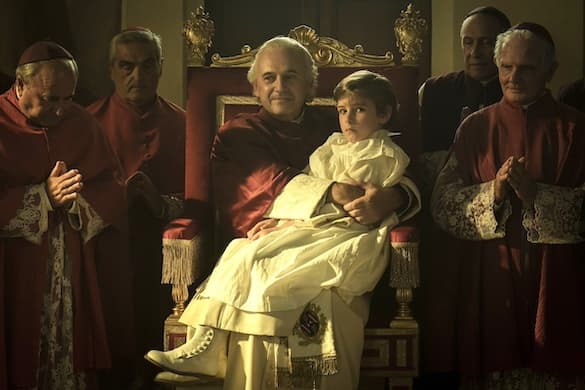Portrayal in New Movie of Infamous Kidnapping of Edgardo Mortara Resembles Opera
‘Kidnapped: The Abduction of Edgardo Mortara’ is based on the true-life story of a Jewish boy in Italy who in 1858 was taken from his family by decree of the Catholic Church after allegedly being baptized.

In 1858, a young Jewish boy living at Bologna, Italy, was taken from his family by decree of the Catholic Church. The child, Edgardo Mortara, was allegedly baptized as a baby by a household maid and therefore, according to law of the land at the time, his religion was Catholicism and his upbringing to be a Christian one. An international scandal at the time, the true-life story makes for a shocking, sweeping new Italian film, “Kidnapped: The Abduction of Edgardo Mortara.”
After a short prologue set in 1851, the movie segues to the night of the abduction. Little Edgardo lives with his brothers and sisters in a comfortably bourgeois, pious household, one in which the Shema is said every night before bed. Soon, though, representatives of the regional Inquisitor arrive and inform Edgardo’s father and mother, Momolo and Marianna, that the boy is to be removed from the family because he had been baptized. The father mobilizes family members and friends to gather more information and to appeal for a stay, and Father Feletti, the inquisitor, gives the family 24 hours in which to say goodbye.
When the time comes to definitively take the boy away, Momolo, in grief, fury, and indignation, threatens to drop him from an upstairs window, but soon the father comes to his senses. This sets the stage not only for the emotional high stakes inherent in the narrative of a child ripped from his parents, but also for the intensifying tenor of the movie’s storytelling style, one in which histrionics, theatrical music, “what if” moments, and even dream sequences heighten the documented drama of the case.
Spirited away to Rome, Edgardo begins his education at a Catechism school. Unacquainted with church iconography, he develops a fascination with images of Jesus on the cross. At the same time, his mother and father make attempts to reunite with their son, recruiting the help of the local Jewish community at Rome, which has had its own problems with the ruling Papal authority.
The couple secure supervised visitations, and during one of these Marianna unleashes a torrent of rage and passion stemming from her powerlessness with her son and his captors. This leads to the child’s wailing wish to go home. Once he’s removed back to the inner sanctum of the school, though, the headmaster quells the boy by denying that anything at all occurred.
We’re also introduced to Pope Pius IX, who’s upset by the deluge of bad press related to the boy’s seizure, yet vows never to return him to his family. He proceeds to take a special interest in the child, re-christening him at an official ceremony. He also meets with several Jewish leaders and not only castigates and threatens them, but makes them kiss his soft-shod feet in a scene filled with grandiosity and outrage.
Actor Paolo Pierobon brings such imperious dynamism to the role of Pius IX that he demands one’s complete attention to the character whenever he’s on screen. As Edgardo, young Enea Sala is photogenic and touching, yet he’s unable to delineate the boy’s growing absorption with the Catholic religion, partly due to director Marco Bellocchio’s more emotive, picturesque, perspective-hopping approach. When the film jumps ahead to years later, and Edgardo is now a young adult played by Leonardo Maltese, his “conversion” is presented as complete, with the acolyte – in a bizarre, psychosexual scene – literally licking the floor to prove his devotion to the church and the pope.
Both Fausto Russo Alesi and Barbara Ronchi give powerful performances as Edgardo’s parents. Later in the film, when Momolo leverages the court system and a more sympathetic government to get his boy back, Mr. Russo Alesi is required to play melodramatically inept, and it’s a testament to his acting ability that his performance remains stirring. By this point, though, the movie has become more of a tour of mid-19th century Italian geopolitics than a portrait of the anguished couple and their kidnapped son. When Pius IX dies in 1878, we’re given an extended sequence of his funeral procession, complete with an allusion to Bertolucci’s “The Conformist,” and yet Momolo’s death isn’t shown at all.
Due to its sprawling nature, the tale of Edgardo Mortara would have been better served as a mini-series. Multiple topics such as Stockholm syndrome, gaslighting, childhood trauma, and cultural isolation – not to mention antisemitism and the intransigence of the Vatican – are only glancingly addressed in its two-hour runtime. Perhaps this cacophony of hot-button issues is one of the reasons why Spielberg, despite extensive pre-production work, decided not to make his own movie of the story, though apparently the inability to find the right child actor to play Edgardo was the ultimate reason.
As it stands, “Kidnapped: The Abduction of Edgardo Mortara” creates a veritable opera of emotional peaks and dreamy valleys among its compacted version of historical events and conjectural moments, with each main character given at least one scene akin to an aria. With riveting, ravishing imagery, the movie laments Edgardo’s fate through the filmic form.

